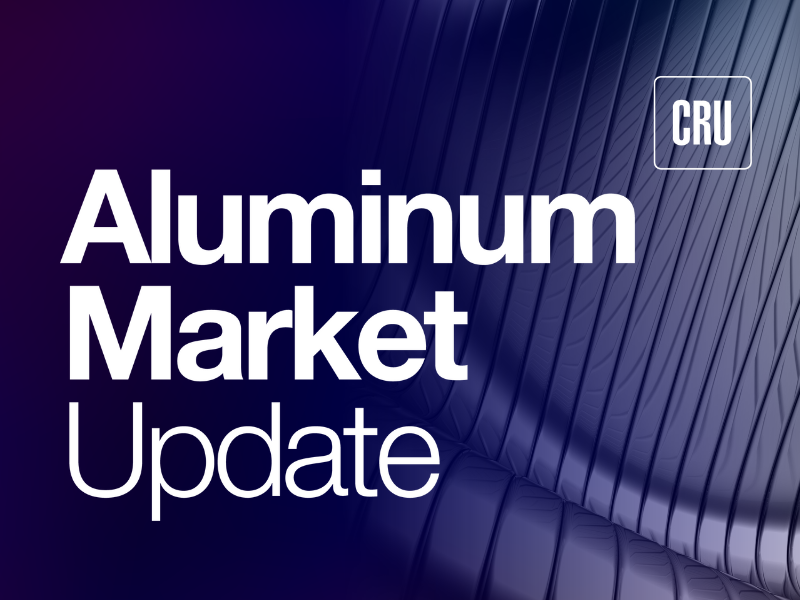Monthly Round-up

October 30, 2025
Monthly Round-Up: Earnings kickoff, tariff talks continue, and more
Written by Stephanie Ritenbaugh
There’s a lot of news to keep track of, so we’re lending a hand with highlights from the past month and what they mean for you.
Survey results
AMU’s September survey of the aluminum market showed that order books softened, inventories tilted slightly toward drawdowns, and producers reported a balanced or undersupplied market, while scrap players highlight and oversupplied market. We get into the details here.
Speaking of surveys, keep an eye out for the results of our October survey soon. And if would like to share your thoughts (anonymously, of course), please contact me at stephanie.ritenbaugh@crugroup.com. Participants always get a first look at the results.
Around the market
The market is still handling the fallout of the outage at Novelis’ Oswego rolling mill in New York. Oswego is a key supplier for the automotive sheet market and produces a modest share of beverage can stock. AMU’s Nicholas Bell looks at the impacts of the outage and when the plant is expected to come back online.
One result of the Oswego outage, caused by a fire in September, is that steelmaker Cleveland-Cliffs said it is optimistic the supply chain disruption will make more automakers consider switching from aluminum to steel. But Steel Dynamics Inc.’s aluminum segment isn’t concerned, AMU’s Stephanie Ritenbaugh reports.
“As we got into the aluminum space and were doing our due diligence for the ADI (Aluminum Dynamics Inc.) project, automotive makers would have actually consumed more aluminum over recent years if there was more supply,” CEO Mark Millett said during an earnings call for Steel Dynamics, ADI’s parent company. “So, are they questioning aluminum? I don’t think so. Aluminum is an incredibly important material for their future plans. Coming into the marketplace will allow them optionality and greater redundancies through the supply chain. I think that issue or that question will be mitigated going forward.”
AMU’s Greg Wittbecker examines trends in truck and rail freight for clues in demand. “Because aluminum is so dependent on trucking for its final mile-delivery, it is important to monitor both freight rates and the index closely for any signs of slowdown. Everyone is focused on when demand destruction might hit, and freight could be our first warning sign.”
Century Aluminum took another step toward restarting idle capacity at its Mt. Holly smelter in South Carolina when it secured a power deal for the facility.
The London Metal Exchange (LME) announced plans to modernize its options market, introducing automated expiry processes and electronic options to enhance liquidity and transparency. These options are used by a wide range of LME market participants, including producers, consumers, intermediaries, and financial participants, to manage price risk. Currently, options are traded only traded through the inter-office market; the launch of LME’s trading platform for options aims to establish a fully electronic options market.
Linamar Corp. reached an agreement to purchase Aludyne’s North American casting and machining assets for $300 million. The deal will transfer most of Aludyne’s domestic precision-casting and machining network to Linamar’s Structures Group under its Mobility segment. Aludyne’s divestiture covers “select assets”, which marks a deeper move by the Canadian-based Linamar into aluminum casting and melt capacity inside the US.
AMU takes a look at the history of fake semi-fabricated products, aka “fake semis.” Why bring this up now? It looks like they could make a comeback.
EGA Spectro Alloys has launched the second phase of a major recycling and billet plant expansion in Rosemount, Minnesota, marking another step in the company’s transition from a foundry alloy producer into a fully integrated secondary billet supplier for the US extrusion market. The project will add about 45,000 metric tons (t) of additional billet recycling capacity per year once completed in 2027.
Demand
What can corrugated cardboard tell us about aluminum demand? Turns out there’s more corrugated material used in the supply chain than meets the eye. Scrap generators, processors, and mill buyers are very familiar with the ubiquitous “gaylord boxes” that handle thousands of tons of aluminum scrap each year. Corrugated material is used in pack-and-ship processes and to ship out maintenance, repair, and operations (MRO) products. So what can trends in packaging tell us about the market?
As if the construction sector wasn’t fragmented enough, the federal government shutdown has made it even more difficult to gauge current conditions as it stopped releasing official data. That leaves privately compiled indicators to assess market conditions. In a two-part look at what that data is telling us, Part One is here and Part Two is here.
Some concerning news for consumer spending: The Consumer Federation of America issued a report in September indicating auto loan delinquencies have risen to levels not seen since before the 2008 global financial crisis. In addition, the number of subprime auto loans is rising.
Power markets
An order by the U.S. Department of the Interior has expanded federal reviews of solar and wind projects, compounding existing cuts to tax credits. “The loss of this potential generating capacity comes at a time when the U.S. can ill afford to delay adding capacity to meet growing electricity demand,” AMU’s Greg Wittbecker wrote. Such power cuts will impact aluminum and steel.
The Department of Energy announced it has finalized a $1.6 billion loan guarantee to AEP Transmission to upgrade 5,000 miles of transmission lines across five states. AEP Transmission is a unit of Columbus, Ohio-based AEP, one of the nation’s largest utilities in terms of generating capacity (31,000 megawatts) and operator of over 40,000 miles of transmission lines.
Scrap
Plans for an ambitious greenfield aluminum recycling and slab-rolling facility in Defiance, Ohio, have stalled, according to multiple local sources familiar with the matter. The project, advanced by Fort-Wayne, Indiana-based MetalX, with support from Manna Capital Partners, was envisioned as a vertically integrated site that would combine advanced scrap processing with the production of low-carbon aluminum slab for use in automotive and packaging markets. Find out more here.
The Aluminum Association is urging the federal government to ban exports of used beverage containers and to take other measures to improve scrap recovery and reuse within the US. The country consumes between 5 million and 6 million metric tons of aluminum scrap annually while exporting more than 2 million metric tons. Meanwhile, much of that aluminum is lost to landfills.
As Aluminum Dynamics Inc. continues to ramp up production at its Mississippi mill, Steel Dynamics Inc.’s chief executive said there is more opportunity ahead.
“We will see how things go over the next six to eight months or so, but there is definitely growth opportunity there. … We could envision sort of exploiting or leveraging our pre-paint capabilities,” SDI’s CEO Mark Millett said during an earnings call. “It’s one of our highest margin product lines today. The team would be incredibly effective to coat the thousands, or millions, of pounds of aluminum that gets painted every year,” Millett said. “And we do believe there’s still clear room for a larger asset, the mill asset.”
Two of Kentucky’s most prominent aluminum producers – Logan Aluminum and Novelis – have received more than $3 million in state transportation grants to expand rail infrastructure. The initiative aims to enhance the logistical ecosystem between Logan’s casting and rolling operations in Russellville and Novelis’ scrap processing operations in Berea.
Tariffs and trade
Of course, there’s more on tariffs. AMU takes a look at aluminum trade groups lobbying to close gaps in Section 232 as more importers try to find less expensive ways to export their goods. Specifically, how derivative coverage is being used to close the remaining gaps in the supply chain.
Another facet of this is the thinking behind finished goods, from wheels and vehicles to cable, powders, and even canned food and beverage products. Imported aluminum wheels are a good example of this.
China is hedging its bets on the future of its trading relationship with the US. China’s exports rose 8.3% year over year in September, but shipments to the US fell, as the country looks elsewhere for trading partnerships.
Earnings
Norsk Hydro reported stable third-quarter production and shipments despite a turbulent aluminum market throughout the period. The results show Hydro holding its operational footing even as profitability becomes harder to predict, with margins swinging sharply year over year, and even quarter to quarter.
Kaiser Aluminum said work is progressing on expansions at two of its plants: the Trentwood rolling mill in Washington and Warrick packaging rolling mill in Indiana. Meanwhile, the company again upwardly revised its full-year adjusted earnings before interest, taxes, depreciation, and amortization (EBITDA) outlook, now expecting improvement of 20%-25% year over year due to “strengthening underlying performance and rising metal prices.”
Coming up
Join AMU and SMU for a special webinar with Shapiro Metals CEO Bruce Shapiro on Thursday, Nov. 6, at 11 am ET.
The live webinar will be free for all to attend. A recording will be available only to AMU and SMU subscribers. You can register here.



